Rooting campsis: description, reproduction and plant care
Rooting campsis belongs to the category of vigorous lianas, which are disembarked in sunny places. This plant is native to North America. It is characterized by ease of maintenance and attractive appearance.
Content:
Description of kampsis taking root
Young shoots of this plant are green in color. After they become lignified, their color becomes light brown. The bark of the shoots begins to peel off after a month. If the plant is old, then the diameter of the shoots can reach several centimeters.
The growing season of kampsis begins in the spring, which protects young shoots from the effects of low temperatures.
Intense growth of vines begins at the end of May and ends at the beginning of June. This plant is characterized by the presence of opposite pinnately complex foliage, the length of which is about 40 centimeters. The color of the leaves of the creeper in the autumn and summer is green. They fall off in the autumn.
Blooms Kampsis in the month of September. The flowers of this plant can have the following color, depending on the variety:
- Yellow
- Red
- Orange
The length of Kampsis flowers can be from 6 to 10 centimeters, and the diameter is from 3 to 5 centimeters. Campsis is characterized by long flowering that begins in mid-summer and ends in late spring. This plant can have fruits in the form of bags, which, after ripening, crack and scatter.
This unusual plant can be used to decorate any area. Due to the large number of Kampsis species, the florist can choose the most suitable option for himself.
Breeding features of Kampsis rooting
Breeding Kampsis is fairly straightforward. This plant has air roots:
- In order to root a plant, its shoot needs only to be pinned to the ground.
- After this, it is necessary to perform watering pinned branch.
- In this state, it is necessary to leave the plant until next spring.
- This plant is very fond of light, so it must be planted in a sunny place.
- Immediately after planting this plant, it must be protected from sunlight, as they can burn it severely.
- The next year, the pinned branch will give roots. It must be disconnected from the plant and, if necessary transplant.
Campsis belongs to the category of aggressive plants. Its roots can easily penetrate into window frames and walls of buildings. That is why it is necessary to plant plants away from buildings.
Also, the reproduction of this plant can be done using seed:
- To do this, you need to collect seeds in the fall.
- The seeds must be stored in a dry and warm place. They are planted in the spring.
- The depth of planting seeds should be no more than half a centimeter.
- At a temperature of +25 degrees, the seeds will sprout in a month.
- After 6 leaves appear on the plant, you can transplant them to a permanent place.
The most effective way to propagate a given plant is to reproduce cuttings:
- This action is performed at the beginning of the flowering of the plant. For this purpose, green shoots from the green part of the plant are used.
- For planting shoots, choose fertile, moist and loose soil in a shaded place.
- Planting cuttings into the ground is carried out at an angle.
- The planting site is covered with leaves so that the area retains a sufficient amount of moisture for their rooting.
Very often, lignified cuttings are used for plant propagation:
- They are cut out immediately after the snow has melted.
- The growth of shoots must necessarily be last year.
- When using this breeding method, it is necessary to immediately select a place of constant growth of the kampsis.
- Planting lignified cuttings, like green ones, is carried out under a slope.
This plant can be propagated by a root cavity. If a large number of shoots have formed around this plant, then they can be cut off along with the root and transplanted to another place.
There are many ways to reproduce this plant.
The choice of the method directly depends on the wishes of the grower. The main thing is to provide him with appropriate care after landing.
Kampsis care
After planting a plant, it needs a special leaving... Special supports are made to it so that it does not break as a result of the winds. In preparation for winter, the plant must be protected at the base. After the plant is planted in the ground in a permanent place, its shoots are cut at a distance of 15 centimeters from the ground. This procedure allows the given plant to bloom.
New shoots, which are strong enough, are expanded into special rods that are placed between the supports.
Plant pruning6
- If there are weak shoots on the campis, they must be removed without fail. After the plant has a solid base, it is necessary to prune weak shoots annually.
- Pruning damaged shoots are carried out completely. This action is performed in the spring.
- In the summer, it is necessary to prune the shoots that thicken the plant. Do not overdo it during pruning, as this can negatively affect vegetative development.
- After severe pruning of Kampsis or damage to its roots, root suckers can form. That is why it is necessary to strictly monitor their growth. When root suckers appear, they must be removed immediately.
Campsis is a frost-resistant plant, but it will not be able to withstand very high frosts. If the cultivation of this plant is carried out in a harsh climate, then it is necessary to cover it. This plant wakes up for a very long time after wintering, so you should not worry that the plant has died.
Campsis is toxic and its juice can irritate the skin. That is why it is necessary to produce plant care as carefully as possible. It will be best to carry out this action with gloves.
Campsis is not only a very beautiful plant, but also quite strong.
This plant needs frequent watering. Otherwise, aphids may form on it. When this pest appears, Kampsis is sprayed with a solution of laundry soap and alcohol.
Kampis is an attractive plant that can be used to decorate walls, slopes and other architectural structures. Plant care consists in pruning it and watering it in time. With proper care, you can provide a fully flowering bush.
More information can be found in the video.



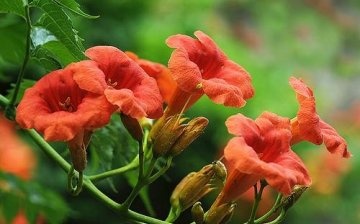
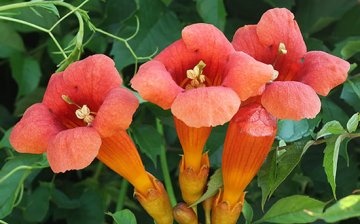
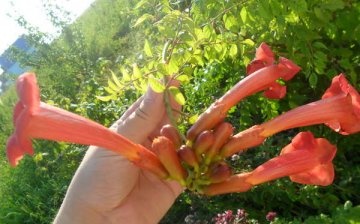
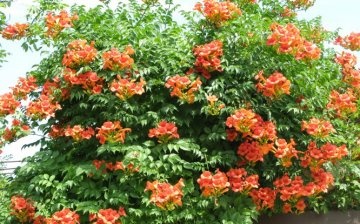




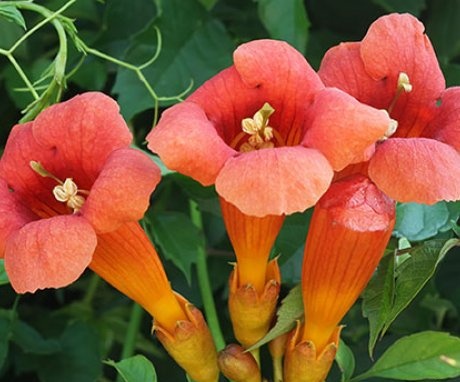
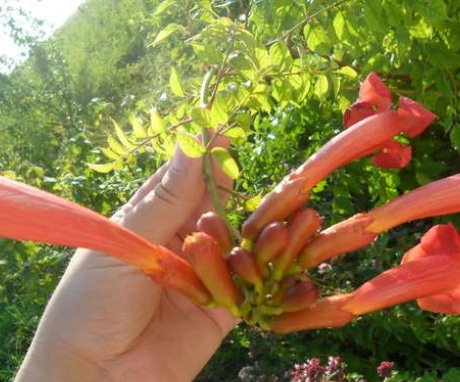
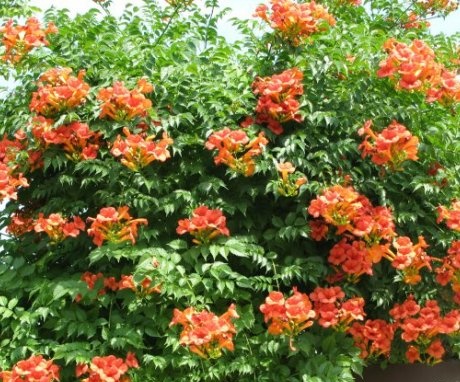
I like him. But for some time now I began to be very attentive to those plants that are ready to turn away a little to fill the whole garden. Alas, judging by the fact that I read it, Kampsis is one of those ...